As the dust settled on Rally Islas Canarias, it became glaringly clear that Hyundai was anything but prepared for the challenges that awaited them. While their World Rally Championship (WRC) competitors, particularly Toyota, were revving at full throttle—achieving a stunning 1-2-3-4 finish—Hyundai found themselves drowning in missed opportunities and strategic blunders. The team’s earlier confidence, built from a strong performance by Thierry Neuville at Rally Sierra Morena, crumbled under the weight of the Canary Islands’ brutal demands. This sudden reversal of fortunes raises questions about the strategic planning and decision-making processes within the Hyundai camp.
Unpacking the Complexity
The crux of Hyundai’s failure in the Canary Islands was not merely their inability to keep up with Toyota’s performance; it was a much deeper issue rooted in their car’s setup and the team’s preparedness. It became apparent that Hyundai had underestimated the unique challenges presented by a pure asphalt event, characterized by its smooth yet treacherous roads. The team struggled with the vehicle’s handling and tire performance across all three cars, crucial elements that could have turned their fortunes around. The chosen differential setups proved to be a critical mistake—one that they could not rectify mid-rally given the sealed components. This glaring oversight not only hampered their performance but also highlighted fundamental shortcomings within the design and engineering of their upgraded i20 N Rally1.
Learning in the Lines
Instead of a fierce competition, the latter stages of the rally morphed into a testing session for Hyundai—a disappointing outcome that smacked of desperation rather than strategy. The team’s focus pivoted to understanding what went wrong with the car, which is not where any professional racing team desires to find themselves. Adrien Fourmaux, emerging as the fastest Hyundai, finished fifth, a staggering 2 minutes and 31 seconds behind Toyota’s Kalle Rovanpera. This result offers a bitter taste of both progress and frustration, as it reveals that within the team itself, there were individual triumphs shadowed by collective failure.
Analyzing the Future
Tanak’s post-rally reflections provide a sobering perspective on the challenges ahead. He emphasized that the lack of pace was symptomatic of deeper complexities within the Hyundai team’s approach. It’s a sentiment that many within the WRC community can resonate with; performance improvement is rarely a straightforward endeavor. While the team has one homologation joker remaining, the path to regaining competitiveness is laden with ambiguity. Tanak’s insight that “big lessons will be taken” sounds hopeful but reveals a lingering uncertainty about the specifics of their required adaptations.
Fourmaux’s perspective injects a sense of guarded optimism. While he shared his frustration over the weekend’s outcome, his belief in Hyundai’s commitment to improvement is a critical touchstone. He pointed out that what transpired during the rally was rally-specific, hinting that the real issue may be isolated rather than indicative of an ongoing struggle. His cool demeanor and resolve to learn from these setbacks will be vital as the season unfolds, especially with upcoming events presenting different challenges.
The Road Ahead
As the WRC season progresses, the onus will be on Hyundai to quickly address the fundamental issues revealed in the Canary Islands. With the next asphalt event looming on the horizon, it’s pivotal for the team to implement the changes necessary to ensure their vehicle performs at optimal levels. Recognizing the pressures of being in a competitive field where every second counts, Hyundai’s engineering and racing teams will need to enhance cooperation and efficiency. The challenge will be steeper if the lessons learned in the Canary Islands are not integrated into their future strategies.
As the rallying world keeps a close watch, the unfolding narrative surrounding Hyundai will be one of resilience. The lessons from this setback could either propel them toward greater success or thicken the cloud of disappointment if not acted upon. How they respond in the subsequent races will define their trajectory and potentially reshape the WRC landscape.


Leave a Reply